While we generally focus our higher-speed networking efforts on 25GbE and faster products these days, 10GbE and specifically 10Gbase-T have been around for some time. The big benefit, which is hard to ignore, is that one can run higher-speed networking on existing wiring. In our Intel X710-T4 review, we are going to take a look at this solution from Intel to address higher-density quad-port 10Gbase-T needs.
Intel X710-T4 Quad-port 10Gbase-T NIC Overview
This particular card one may initially think is older technology since it is 10Gbase-T. That is not the case. Intel previously had 10GbE NICs in its 500 series such as the X540-T2 and X550-T2. Those cards were based on the Intel 500 series which uses the ixgbe driver and was designed for the 10GbE generation. If you have an Intel Xeon D-1500 series, then you have an embedded 500 series NIC. As time progressed, we saw the Intel 700 series launch which we covered in 2014 via 40GbE Intel Fortville XL710: Networking will never be the same.
Over time, that 700 series IP has gone from only covering the 40GbE market to also covering the 10GbE market. Specifically, we looked at this in our Intel X710-DA2 OCP NIC 3.0 Review and 3rd Party Intel X710-DA4 Quad 10GbE NIC Review. The Intel 700 series IP is also used in the Lewisburg PCH NICs (not the refresh for 3rd Gen Xeon Scalable), in the Xeon D-2100 series, and elsewhere. One of those places is now in the quad 10Gbase-T space.
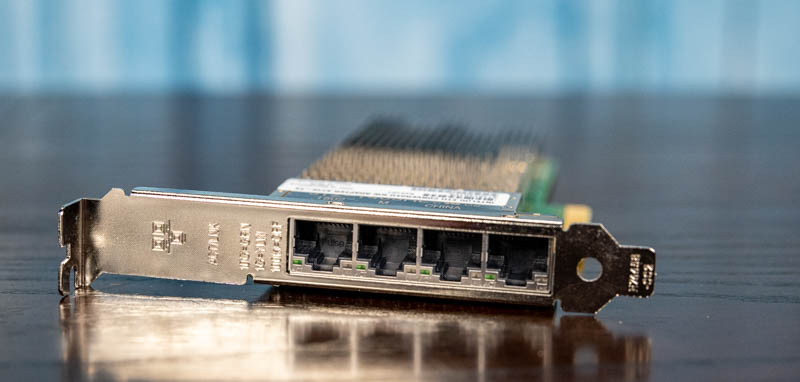
The Intel X710-T4 has four RJ45 ports as one would expect. One can also see that the card is a low-profile design so we can use either low-profile or full-height brackets. Intel did have to make a small concession here. Specifically one can see the block of RJ45 ports extends further down than on many cards below the main bottom line of the card’s PCB. There is a screw for the bracket on top of the unit so Intel had to do this to make a low-profile card.
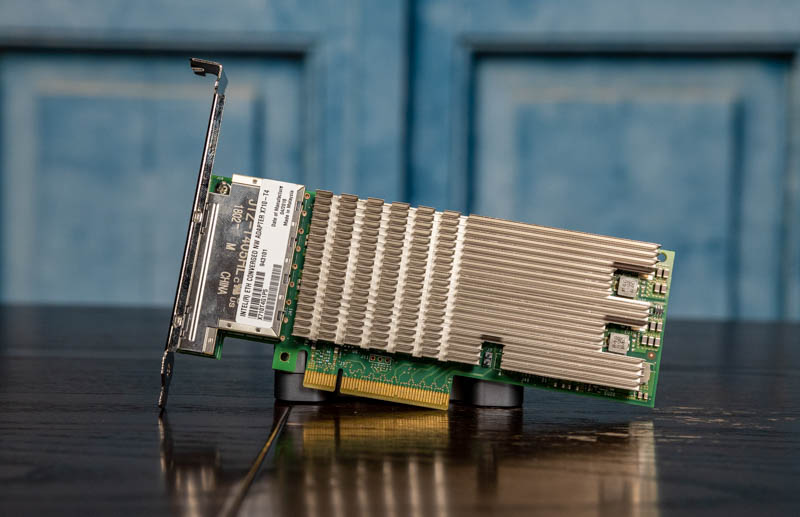
Since this is based on the Intel 700 series IP, this is a PCIe Gen3 x8 card. The Intel X540-T2, for example, is a PCIe 2.1 card. The X550-T2 is a dual-port 500 series card with PCIe Gen3 support. While the X550-T2 can be a PCIe 3.0 x4 card with only two 10Gbps ports, the X710-T4 with four 10Gbps ports needs to be a PCIe 3.0 x8 card to not limit bandwidth via the PCIe bus.
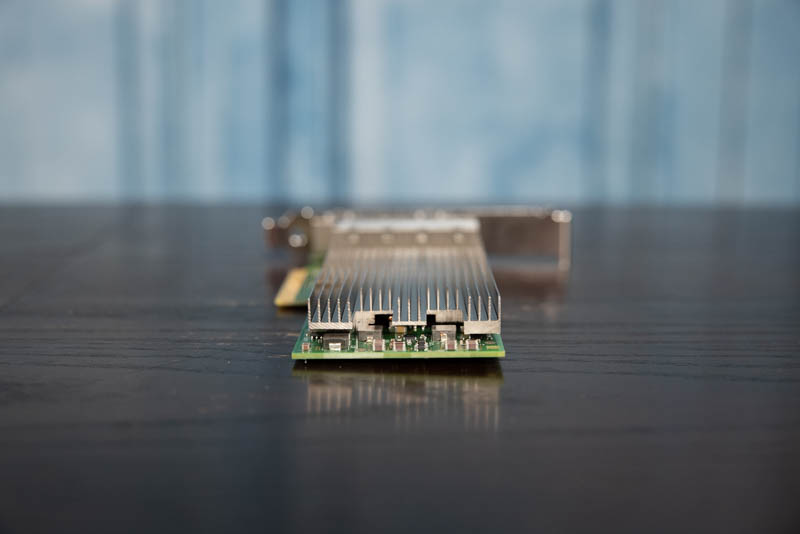
One will notice there is a fairly large passive heatsink on this compared to some of even the 40GbE cards we have seen. This is far from a low-power card. Indeed, we were able to fairly consistently get this card to pull around 24W which is in-line with the specs which are 23.7W typical and up to 28.9W. This clearly uses a lot of power.
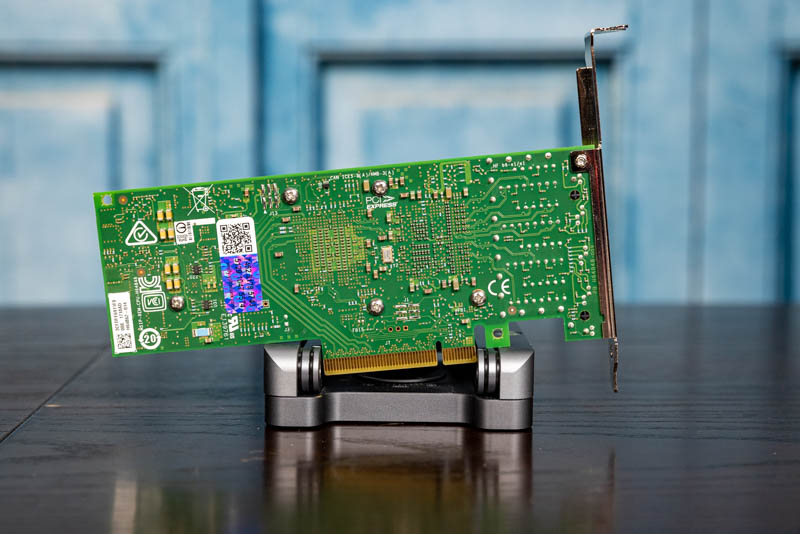
Aside from the power, one may notice that Intel released an updated card in Q3 2020 called the Intel X710-T4L. We wanted to discuss that briefly.
Intel X710-T4 v. X710-T4L
Some may wonder what the difference is between these two cards. One may wonder why there was an updated X710-T4L and it appears as though there are a few big changes.
First, the X710-T4 has the Intel X710 controller while the X710-T4L uses the X710-TM4. That changes a number of options. Both are rated for CAT6 to 55m and CAT6a up to 100m at 10Gbase-T speeds. The X710-T4L is rated for up to 100m using 2.5Gbase-T 5Gbase-T even on CAT5e/ CAT6. So the new unit is compatible with 2.5GbE/5GbE longer runs on many existing wiring segments where the older card is not.
The second one we found is how we realized there was a difference, and that is in supported port speeds.
Here is the ethtool output for one of the ports on the X710-T4 card:
Supported ports: [ TP ]
Supported link modes: 100baseT/Full
1000baseT/Full
10000baseT/Full
Supported pause frame use: Symmetric
Supports auto-negotiation: Yes
Supported FEC modes: Not reported
Advertised link modes: 100baseT/Full
1000baseT/Full
10000baseT/Full
Advertised pause frame use: No
Advertised auto-negotiation: Yes
Advertised FEC modes: Not reported
Speed: 10000Mb/s
Duplex: Full
Port: Twisted Pair
PHYAD: 0
Transceiver: internal
Auto-negotiation: on
MDI-X: Unknown
Supports Wake-on: g
Wake-on: g
Current message level: 0x00000007 (7)
drv probe link
Link detected: yes
We did not have the X710-T4L, but we had a lab server with the new -TM controller built-in. Here is the port output from that setup:
Supported ports: [ TP ]
Supported link modes: 100baseT/Full
1000baseT/Full
10000baseT/Full
2500baseT/Full
5000baseT/Full
Supported pause frame use: Symmetric
Supports auto-negotiation: Yes
Supported FEC modes: Not reported
Advertised link modes: 100baseT/Full
1000baseT/Full
10000baseT/Full
2500baseT/Full
5000baseT/Full
Advertised pause frame use: No
Advertised auto-negotiation: Yes
Advertised FEC modes: Not reported
Speed: 10000Mb/s
Duplex: Full
Port: Twisted Pair
PHYAD: 0
Transceiver: internal
Auto-negotiation: on
MDI-X: Unknown
Supports Wake-on: g
Wake-on: g
Current message level: 0x00000007 (7)
drv probe link
Link detected: yes
This may seem similar at first, but the difference is large. The newer controller adds support for 2.5GbE and 5GbE speeds.
One other item we looked up is power consumption. On the quad-port model, the Intel X710-T4L is rated at 13.6W typical and 14.2W maximum. Those are over 10W lower than the 23.7W typical and up to 28.9W on the X710-T4.
For many of our readers, the original X710-T4 may be deployed in networks and may be the SKU they search for. In reality, the X710-T4L seems to be a major update.
Intel X710-T4 Performance
We received about the performance we would expect from a solution like this:
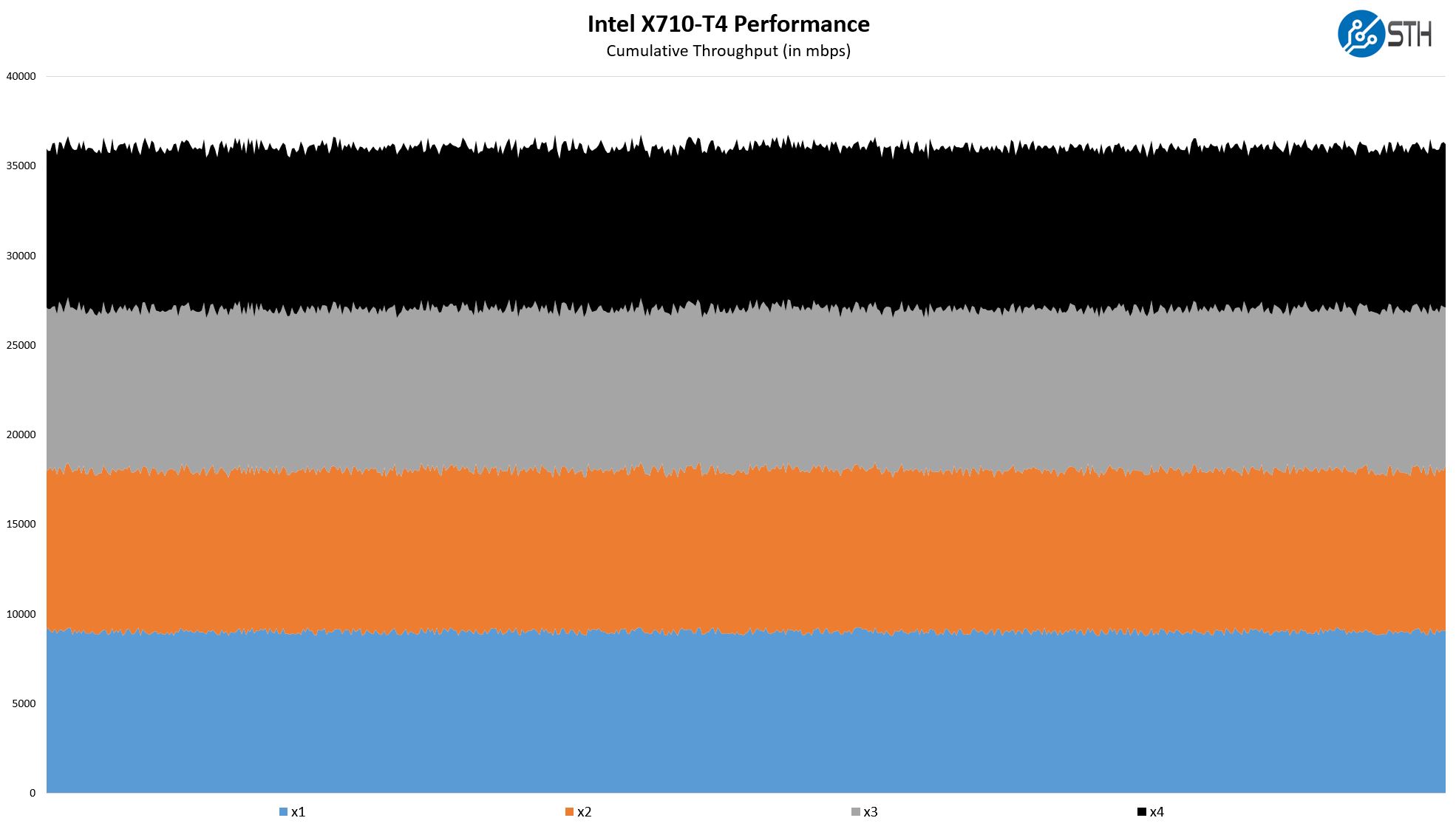
There is not much that we are going to go into here, other than validating that this indeed is a quad 10Gbase-T card, not a quad 1Gbase-T card. If you are looking for a specific feature, check out Intel’s documentation which is generally very good for networking products.
Final Words
This is an interesting product at STH. Technically it is a current-generation product that is qualified by a number of server vendors, and it does exactly what it states it will. At the same time, aside from vendor qualifications, we have difficulty justifying this card over an X710-T4L card even though we have not tested the latter. Again, we have a number of systems that integrate the newer controller though, so it is not that we have no experience with the new chip, it is just not with the specific model.

With all that said, 40-50% power savings, 2.5GbE/ 5GbE support, and better cabling support at effectively the same price point make it extremely difficult for us to recommend this card now that the X710-T4L is out. Just before publication and this X710-T4 is still on sale and being sold in systems from a number of vendors. We understand that once a piece of networking gear is qualified, organizations like to stick with the solution and not change. At the same time, for STH readers looking at cards, we are going to push away from this card in 2021 and recommend looking at the X710-T4L instead.

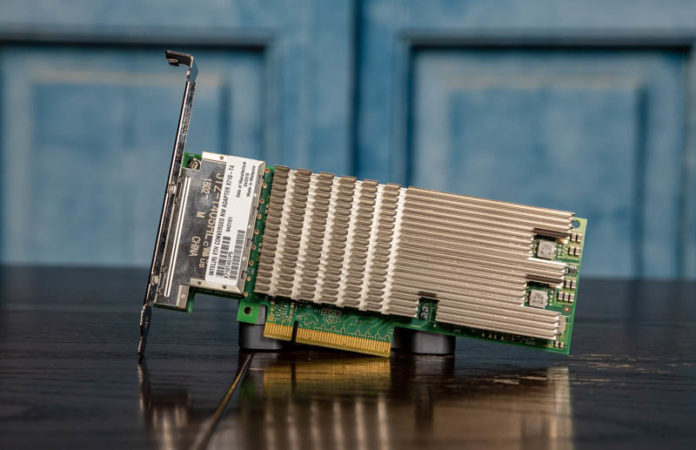
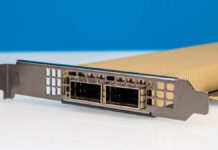
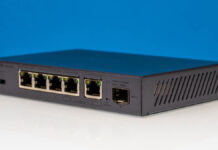
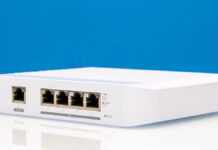
Sensational “not recommended” aside, I get the point. I for one didn’t even know Intel released the X710-t4l and we have thousands of -t4 ports installed.
The scoring and grading system really doesn’t make sense. Grading a non recommended product 8/10 should be a good indication of this. Why not remove those grades and instead give products different STH awards? That way you can write a nuanced opinion and choose whether or not you’re recommending a product. Think of STH Value Award / STH Ultimate Award / STH Recommended Award etc
@David
but wouldn’t you agree that this piece of hardware is extremly pretty and cool looking, and deservedly earned a 9 of 10 for “Design & Aesthetics”? Funny how good looks can lift a score from what would be a 7.6 across the other three categories to a score of 8.0, eh? ;-P
I don’t know, but i don’t recall to have ever seen a score here on STH that is lower than an 8. If there are scores that a 7-point-something or lower, at least in the recent past they have been exceedingly rare. The scoring here on STH feels to me like a case of chōchin–kiji, as the Japanese would say. I very much like reading the write-ups on STH, but i have to come to see the scoring as no more than nonsense devoid of any meaning…
Yikes. Dr. Manhattan 4.6 a few weeks ago https://www.servethehome.com/trendnet-tuc-et5g-usb-type-c-to-5gbe-nic-review/ Here is a 7.5 https://www.servethehome.com/startech-usb-to-5gbe-adapter-review/ no idea where you are coming from with that.
The design is a big deal since physically putting four of these ports on a board like this actually requires a bit of extra design which Rohit highlighted. Dual-port cards are easy, quad ports are more difficult.
David – this is easy. This is still a good and valid product, but we would recommend getting the T4L (which we did not review, but would score higher.) The “would not recommend” is just because there is a newer/ better version. Had we reviewed this 3 quarters ago, this would be the best out there.
On the “Value Award” and such that you see on other sites, let us be clear what those are. Those are given so that they can be licensed to companies for big dollars. Marketing folks at companies have award quotas and budgets. There are other IT hardware and even sites that do “best of” or “top 10” that are solely made to license the inclusion to vendors. If you see a site that gives an award weekly, or on every server review, it is due to a business model where they are effectively being paid to give an award. Given STH’s size, we could adopt that model. I want to keep editorial independence which is why I do not want that. I do understand that a lot of that is not well disclosed on the Internet and people that do not know think they are more genuine awards. There is a server review site out there that operates on this model so I am sensitive to it.
@Patrick your reference to other tech sites seems overly negative. For example hardware.info uses this label/awards system and manufacturers can use the awards free of charge and cannot pay to receive an award.
What I’m missing in your response is on the substance of the critique, namely that the current grading and ranking is devoid of meaning (and frequent subject of mockery in the comments). This by itself should indicate that some other form of providing a score or evaluation would be more effective at conveying your opinion.
David – I think the main point is that the server space is so competitive, and the barrier to entry is so high that products that are 6/10 or 7/10 are basically unsellable. It would be rare to see a sub 8/10 product just because it would not make it to market and be competitive. There is also some selection bias since I generally would not buy something bad just to give something a low scoring review.
Instead of doing awards, we have been doing something a bit more objectively based on specs/numbers on the STH Server Spider. That is not perfect, but it does show a scale more to what you may be looking for. It is hard to roll that out to something like NICs just because it is a different type of product.
Also, when we are lumped into coverage groups, hardware.info is usually in a different segment. If you look specifically at sites that do DC coverage, it is prevalent.
I actually bought one of these myself recently on ebay for £200. Really affordable used and works perfect in my pfSense box. I did see the X710-T4L was already available when I was looking at ebay but the price difference was staggering.
Like £700 for the L or £200 for the non-L. Since I didn’t need 2.5/5GbE and could deal with the higher TDP (I ended up sticking a Noctua 60mm fan on the card) I went with the much cheaper option.
Plug and play in pfSense by the way.
Frankly, I never even look at the score. Picking even a simple product just on a single number is not my kind of thing. I want to know the details and make up my own mind considering my own set of criteria.
Both cards do not support Windows 10. It’s a big shame IMHO
Windows 10 is not supported? You are kidding right? Just use the Intel driver pack.
Shyly1974:
Officially it’s unsupported:
https://www.intel.com/content/www/us/en/support/articles/000025890/network-and-i-o/ethernet-products.html
And yes, I know it works somehow with Intel driver.
I purchased the X710-T4L and my Dell OptiPlex 4060 MT does not recognize it. The vendor said that the 4060 does not have the BIOS or firmware to support the 4060. I am attempting to turn a refurbished business PC into a router. What minimum specs do I need to run the T4L? I am also considering the E810 as well.